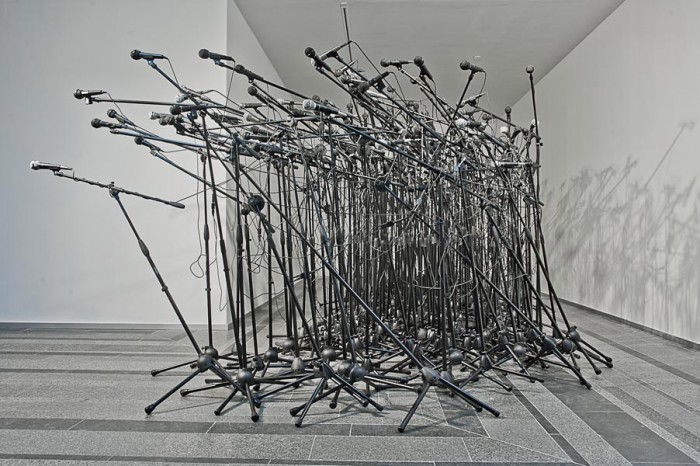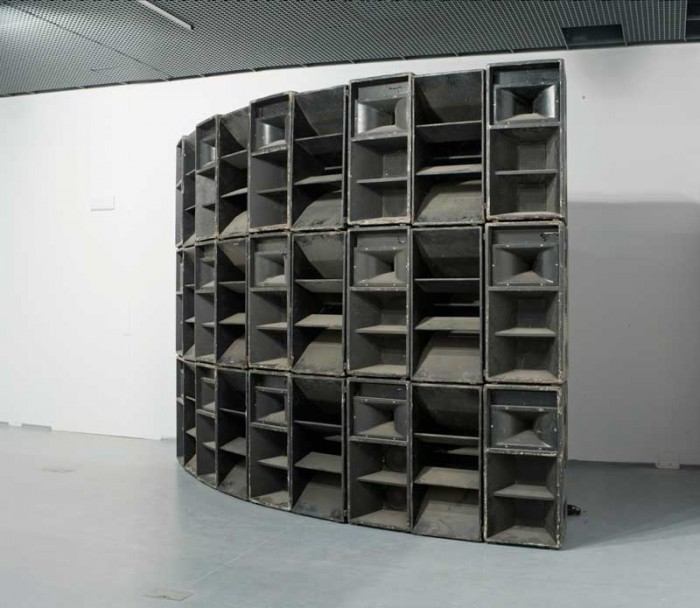The oscillation between noise, sound, and silence is further explored in Basanta’s series, The Sound of Empty Space (2015). Each work draws attention to the way in which aural dynamics can be imposed on audiences and the extent to which sonic phenomena are enfolded within cultural and social relations, especially within a gallery context. The three pieces that comprise the series each manifest as a discrete sound system inflected by feedback.
Vessel (2015)consists of a diminutive lavalier microphone and a small speaker cone placed inside a large glass jar that is sealed with a cork. The speaker traverses the container, its movement governed by a linear metal track. The speaker advances and retreats from the mic at irregular intervals, which directly and immediately alters a tone of self-generated feedback. The jar is its own enclosed acoustic environment, and the sound that fills it is the outcome of the object’s natural resonance. Only through headphones are gallery visitors able to enter the jar’s sonic space.
The cultural connotations of the lavalier microphone are significant here. They are most frequently used to capture and amplify the human voice for television, theatre, or public speaking. In Vessel, the human voice is dispelled, and the ambient sound of sealed space is amplified instead. As Basanta explains in the work’s description, the speaker and microphone serve as “stand-ins for their corporeal correlates, the ear and mouth” while drawing attention to “the status of the ‘amplified’” (Basanta 2015). Basanta deconstructs the elements of a conventional sound system by merging the speaker and the microphone so that they rely only on each other rather than receiving input from an external human intermediary. This system is intentionally flawed and disrupts the sonic information assumed by a conventional flow of amplified communication. Basanta goes on to describe this work as a system that “offers no resolution” while refocusing the listener toward “the empty space between components” (Basanta 2015).
The central thematics of Vessel recalls The End of Radio (2012) by Polish artist Konrad Smoleński, which assembles approximately 200 microphones that emit a signal rather than receiving one, or Microphones (2007) in which the Mexican-Canadian electronic artist Rafael Lozano-Hemmer embeds speakers inside his microphones so that they can capture and emit sound. Like Basanta, it is Smoleński’s intention to reverse the primary function of the microphone in order to reflect on and resist the over-saturation of our media landscape. Smoleński’s installation fills the gallery with a soundscape of noisy interference. This cacophony is caused by the microphones that feed off each other and foist the results onto the listener. The title of the piece is based on a song by the American noise rock band Shellac. The song’s lyrics repeat “Can You Hear Me Now? Can You Hear Me Now?” as the band’s members question whether a message can be transmitted in the absence of a listener. The End of Radio creates an aggressive atmosphere that gallery visitors may find disturbing. A similar sense of sonic invasion is conjured by Smoleński’s sound sculpture There’s No God (2009) which consists of a wall of dilapidated speakers. The use of speakers is a recurring motif in his work, appearing often in large quantities, “evok[ing] a mix of anxiety, disorientation, and awe” (Kedmey 2014). As Smoleński writes, “After all of the elements have been connected, the assembly gives out a characteristic, monotonous hiss, or ‘dirty’ electrical noise caused by [the] poor quality of the components and high amplification without a source of signal” (Smoleński 2010). This work, like many of Smoleński’s works, including his 2013 contribution to the Venice Biennale Everything Was Forever, Until It Was No More, inspires a sense of expectation, inescapable dread, and tension, elicited through ear-piercing sounds.



